- Home
- D. H. Lawrence
Life with a Capital L Page 8
Life with a Capital L Read online
Page 8
In Christ I must save my soul through love, I must lose my life, and thereby find it. The Law bids me preserve my life to the Glory of God. But Love bids me lose my life to the Glory of God. In Christ, when I shall have overcome every desire I know in myself, so that I adhere to nothing, but am loosed and set free and single, then, being without fear, and having nothing that I can lose, I shall know what I am, I, transcendent, intrinsic, eternal.
The Christian commandment: ‘Thou shalt love thy neighbour as thyself’ is a more indirect and moving, a more emotional form of the Greek commandment ‘Know thyself.’ This is what Christianity says, indirectly: ‘Know thyself, and each man shall thereby know himself.’
Now in the Law, no man shall know himself, save in the Law. And the Law is the immediate law of the body. And the necessity of each man to know himself, to achieve his own consummation, shall be satisfied and fulfilled in the body. God, Almighty God, is the father, and in fatherhood man draws nearest to him. In the act of love, in the act of begetting, Man is with God and of God. Such is the Law. And there shall be no other God devised. That is the great obstructive commandment.
This is the old religious leap down, absolutely, even if not in direct statement. It is the Law. But through Christ it was at last declared that in the physical act of love, in the begetting of children, man does not necessarily know himself, nor become Godlike, nor satisfy his deep, innate desire to BE. The physical act of love may be a complete disappointment, a nothing, and fatherhood may be the least significant attribute to a man. And physical love may fail utterly, may prove a sterility, a nothingness. Is a man then duped, and is his deepest desire a joke played on him?
There is a law, beyond the known law, there is a new Commandment. There is love. A man shall find his consummation the crucifixion of the body and the resurrection of the spirit.
Christ, the Bridegroom, or the Bride, as may be, awaits the desiring soul that shall seek Him, and in Him shall all men find their consummation, after their new birth. It is the New Law; the old Law is revoked.
‘This is my Body, take, and eat,’ says Christ, in the Communion, the ritual representing the Consummation. ‘Come unto Me all ye that labour and are heavy-laden, and I will give you rest.’
For each man there is the bride, for each woman the bridegroom, for all, the Mystic Marriage. It is the New Law. In the mystic embrace of Christ each man shall find fulfilment and relief, each man shall become himself, a male individual, tried, proved, completed, and satisfied. In the mystic embrace of Christ each man shall say, ‘I am myself, and Christ is Christ’; each woman shall be proud and satisfied, saying, ‘It is enough.’
So, by the New Law, man shall satisfy this his deepest desire. ‘In the body ye must die, even as I died, on the cross,’ says Christ, ‘that ye may have everlasting life.’ But this is a real contradiction of the Old Law, which says, ‘In the life of the body we are one with the Father.’ The Old Law bids us live: it is the old, original commandment, that we shall live in the Law, and not die. So that the new Christian preaching of Christ Crucified is indeed against the Law. ‘And when ye are dead in the body, ye shall be one with the spirit, ye shall know the Bride, and be consummate in Her Embrace, in the Spirit,’ continues the Christian Commandment.
It is a larger interpretation of the Law, but, also, it is a breach of the Law. For by the Law, Man shall in no wise injure or deny or desecrate his living body of flesh, which is of the Father. Therefore, though Christ gave the Holy Ghost, the Comforter; though He bowed before the Father; though He said that no man should be forgiven the denial of the Holy Spirit, the Reconciler between the Father and the Son; yet did the Son deny the Father, must he deny the Father?
‘Ye are my Spirit, in the Spirit ye know Me, and in marriage of the Spirit I am fulfilled of you,’ said the Son.
And it is the Unforgivable Sin to declare that these two are contradictions one of the other, though contradictions they are. Between them is linked the Holy Spirit, as a reconciliation, and whoso shall speak hurtfully against the Holy Spirit shall find no forgiveness.
So Christ, up in arms against the Father, exculpated Himself and bowed to the Father. Yet man must insist either on one or on the other: either he must adhere to the Son or to the Father. And since the Renaissance, disappointed in the flesh, the northern races have sought the consummation through Love; and they have denied the Father.
The greatest and deepest human desire, for consummation, for Self-Knowledge, has sought a different satisfaction. In Love, in the act of Love, that which is mixed in me becomes pure, that which is female in me is given to the female, that which is male in her draws into me, I am complete, I am pure male, she is pure female; we rejoice in contact perfect and naked and clear, singled out unto ourselves, and given the surpassing freedom. No longer we see through a glass, darkly. For she is she, and I am I, and, clasped together with her, I know how perfectly she is not me, how perfectly I am not her, how utterly we are two, the light and the darkness, and how infinitely and eternally not-to-be-comprehended by either of us is the surpassing One we make. Yet of this One, this incomprehensible, we have an inkling that satisfies us.
And through Christ Jesus, I know that I shall find my Bride, when I have overcome the impurity of the flesh. When the flesh in me is put away, I shall embrace the Bride, and I shall know as I am known.
But why the Schism? Why shall the Father say ‘Thou shalt have no other God before Me’? Why is the Lord our God a jealous God? Why, when the body fails me, must I still adhere to the Law, and give it praise as the perfect Abstraction, like Raphael, announce it as the Absolute? Why must I be imprisoned within the flesh, like Michelangelo, till I must stop the voice of my crying out, and be satisfied with a little where I wanted completeness?
And why, on the other hand, must I lose my life to save it? Why must I die, before I can be born again? Can I not be born again, save out of my own ashes, save in resurrection from the dead? Why must I deny the Father, to love the Son? Why are they not One God to me, as we always protest they are?
It is time that the schism ended, that man ceased to oppose the Father to the Son, the Son to the Father. It is time that the Protestant Church, the Church of the Son, should be one again with the Roman Catholic Church, the Church of the Father. It is time that man shall cease, first to live in the flesh, with joy, and then, unsatisfied, to renounce and to mortify the flesh, declaring that the Spirit alone exists, that Christ He is God.
If a man find incomplete satisfaction in the body, why therefore shall he renounce the body and say it is of the devil? And why, at the start, shall a man say, ‘The body, that is all, and the consummation, that is complete in the flesh, for me.’
Must it always be that a man set out with a worship of passion and a blindness to love, and that he end with a stern commandment to love and a renunciation of passion?
Does not a youth now know that he desires the body as the via media, that consummation is consummation of body and spirit, both?
How can a man say, ‘I am this body,’ when he will desire beyond the body tomorrow? And how can a man say, ‘I am this spirit,’ when his own mouth gives lie to the words it forms?
Why is a race, like the Italian race, fundamentally melancholy, save that it has circumscribed its consummation within the body? And the Jewish race, for the same reason, has become now almost hollow, with a pit of emptiness and misery in their eyes.
And why is the English race neutral, indifferent, like a thing that eschews life, save that it has said so insistently: ‘I am this spirit. This body, it is not me, it is unworthy’? The body at last begins to wilt and become corrupt. But before it submits, half the life of the English race must be a lie. The life of the body, denied by the professed adherence to the spirit, must be something disowned, corrupt, ugly.
Why should the worship of the Son entail the denial of the Father?
Since the Renaissance, northern humanity has sought for consummation in the spirit, it has sought for the female
apart from woman. ‘I am I, and the Spirit is the Spirit; in the Spirit I am myself,’ and this has been the utterance of our art since Raphael.
There has been the ever-developing dissolution of form, the dissolving of the solid body within the spirit. He began to break the clear outline of the object, to seek for further marriage, not only between body and body, not the perfect, stable union of body with body, not the utter completeness and accomplishment of architectural form, with its recurrent cycles, but the marriage between body and spirit, or between spirit and spirit.
It is no longer the Catholic exultation ‘God is God,’ but the Christian annunciation, ‘Light is come into the world.’ No longer has a man only to obey, but he has to die and be born again; he has to close his eyes upon his own immediate desires, and in the darkness receive the perfect light. He has to know himself in the spirit, he has to follow Christ to the Cross, and rise again in the light of the life.
And, in this light of life, he will see his Bride, he will embrace his complement and his fulfilment, and achieve his consummation. ‘It is the spirit that quickeneth; the flesh forgetteth nothing; the words I speak unto you, they are the spirit, and they are life.’
And though in the Gospel, according to John particularly, Jesus constantly asserts that the Father has sent Him, and that He is of the Father, yet there is always the spirit of antagonism to the Father.
‘And it came to pass, as He spake these things, a certain woman of the company lifted up her voice and said unto Him: “Blessed is the womb that bare thee, and the paps thou hast sucked.”
‘But He said, Yea, rather, blessed are they that hear the word of God, and keep it.’
And the woman who heard this knew that she was denied of the honour of her womb, and that the blessing of her breasts was taken away.
Again He said: ‘And there be those that were born eunuchs, and there be those that were made eunuchs by men, and there be eunuchs which have made themselves eunuchs for the kingdom of heaven’s sake. He that is able to receive it, let him receive it.’ But before the Father a eunuch is blemished, even a childless man is without honour.
So that the spirit of Jesus is antagonistic to the spirit of the Father. And St John enhances this antagonism. But in St John there is the constant insistence on the Oneness of Father and Son, and on the Holy Spirit.
Since the Renaissance there has been the striving for the Light, and the escape from the Flesh, from the Body, the Object. And sometimes there has been the antagonism to the Father, sometimes reconciliation with Him. In painting, the Spirit, the Word, the Love, all that was represented by John, has appeared as light. Light is the constant symbol of Christ in the New Testament. It is light, actual sunlight or the luminous quality of day, which has infused more and more into the defined body, fusing away the outline, absolving the concrete reality, making a marriage, an embrace between the two things, light and object.
In Rembrandt there is the first great evidence of this, the new exposition of the commandment ‘Know thyself.’ It is more than the ‘Hail, holy Light!’ of Milton. It is the declaration that light is our medium of existence, that where the light falls upon our darkness, there we are: that I am but the point where light and darkness meet and break upon one another.
There is now a new conception of life, an utterly new conception, of duality, of two-fold existence, light and darkness, object and spirit two-fold, and almost inimical.
The old desire, for movement about a centre of rest, for stability, is gone, and in its place rises the desire for pure ambience, pure spirit of change, free from all laws and conditions of being.
Henceforward there are two things, and not one. But there is journeying towards the one thing again. There is no longer the One God Who contains us all, and in Whom we live and move and have our being, and to Whom belongs each one of our movements. I am no longer a child of the Father, brother of all men. I am no longer part of the great body of God, as all men are part of it. I am no longer consummate in the body of God, identified with it and divine in the act of marriage.
The conception has utterly changed. There is the Spirit, and there is Myself. I exist in contact with the Spirit, but I am not the Spirit. I am other, I am Myself. Now I am become a man, I am no more a child of the Father. I am a man. And there are many men. And the Father has lost his importance. We are multiple, manifold men, we own only one Hope, one Desire, one Bride, one Spirit.
At last man insists upon his own separate Self, insists that he has a distinct, inconquerable being which stands apart even from Spirit, which exists other than the Spirit, and which seeks marriage with the Spirit.
And he must study himself and marvel over himself in the light of the Spirit, he must become lyrical: but he must glorify the Spirit, above all. Since that is the Bride. So Rembrandt paints his own portrait again and again, sees it again and again within the light.
He has no hatred of the flesh. That he was not completed in the flesh, even in the marriage of the body, is inevitable. But he is married in the flesh, and his wife is with him in the body, he loves his body, which she gave him complete, and he loves her body, which is not himself, but which he has known. He has known and rejoiced in the earthly bride, he will adhere to her always. But there is the Spirit beyond her: there is his desire which transcends her, there is the Bride still he craves for and courts. And he knows, this is the Spirit, it is not the body. And he paints it as the light. And he paints himself within the light. For he has a deep desire to know himself in the embrace of the spirit. For he does not know himself, he is never consummated.
In the Old Law, fulfilled in him, he is not appeased, he must transcend the Law. The Woman is embraced, caught up, and carried forward, the male spirit, passing on half satisfied, must seek a new bride, a further consummation. For there is no bride on earth for him.
To Dürer, the whole earth was as a bride, unknown and unaccomplished, offering satisfaction to him. And he sought out the earth endlessly, as a man seeks to know a bride who surpasses him. It was all: the Bride.
But to Rembrandt the bride was not to be found, he must react upon himself, he must seek in himself for his own consummation. There was the Light, the Spirit, the Bridegroom. But when Rembrandt sought the complete Bride, sought for his own consummation, he knew it was not to be found, he knew she did not exist in the concrete. He knew, as Michelangelo knew, that there was not on the earth a woman to satisfy him, to be his mate. He must seek for the Bride beyond the physical woman; he must seek for the great female principle in an abstraction.
But the abstraction was not the geometric abstraction, created from knowledge, a state of Absolute Remembering, making Absolute of the Consummation which had been, as in Raphael. It was the desired Unknown, the goodly Unknown, the Spirit, the Light. And with this Light Rembrandt must seek even the marriage of the body. Everything he did approximates to the Consummation, but never can realize it. He paints always faith, belief, hope; never Raphael’s terrible, dead certainty.
To Dürer, every moment of his existence was occupied. He existed within the embrace of the Bride, which embrace he could never fathom nor exhaust.
Raphael knew and outraged the Bride, but he harked back, obsessed by the consummation which had been.
To Rembrandt, woman was only the first acquaintance with the Bride. Of woman he obtained and expected no complete satisfaction. He knew he must go on, beyond the woman. But though the flesh could not find its consummation, still he did not deny the flesh. He was an artist, and in his art no artist ever could blaspheme the Holy Spirit, the Reconciler. Only a dogmatist could do that. Rembrandt did not deny the flesh, as so many artists try to do. He went on from her to the fuller knowledge of the Bride, in true progression. Which makes the wonderful beauty of Rembrandt.
But, like Michelangelo, owning the flesh, and a northern Christian being bent on personal salvation, personal consummation in the flesh, such as a Christian feels with us when he receives the Sacrament and hears the words ‘This is My Body, t
ake, and eat,’ Rembrandt craved to marry the flesh and the Spirit, to achieve consummation in the flesh through marriage with the Spirit.
Which is the great northern confusion. For the flesh is of the flesh, and the Spirit of the Spirit, and they are two, even as the Father and the Son are two, and not One.
Raphael conceived the two as One, thereby revoking Time. Michelangelo would have created the bridal Flesh, to satisfy himself. Rembrandt would have married his own flesh to the Spirit, taken the consummate Kiss of the Light upon his fleshly face.
Which is a confusion. For the Father cannot know the Son, nor the Son the Father. So, in Rembrandt, the marriage is always imperfect, the embrace is never close nor consummate, as it is in Botticelli or in Raphael, or in Michelangelo. There is an eternal non-marriage betwixt flesh and spirit. They are two; they are never Two-in-One. So that in Rembrandt there is never complete marriage betwixt the Light and the Body. They are contiguous, never.
This has been the confusion and the error of the northern countries, but particularly of Germany, this desire to have the spirit mate with the flesh, the flesh with the spirit. Spirit can mate with spirit, and flesh with flesh, and the two matings can take place separately, flesh with flesh, or spirit with spirit. But to try to mate flesh with spirit makes confusion.

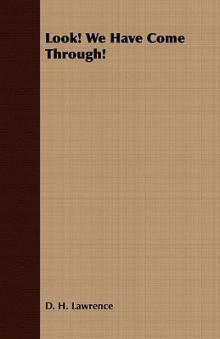 Look! We Have Come Through!
Look! We Have Come Through! Women in Love
Women in Love The Ladybird
The Ladybird The Rainbow
The Rainbow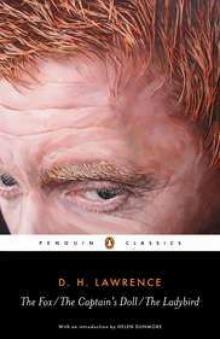 The Captain's Dol
The Captain's Dol The White Peacock
The White Peacock Amores
Amores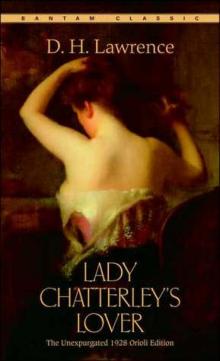 Lady Chatterley's Lover
Lady Chatterley's Lover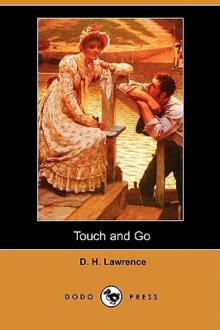 Touch and Go
Touch and Go The Wintry Peacock
The Wintry Peacock Life with a Capital L
Life with a Capital L The Lost Girl
The Lost Girl Sons and Lovers
Sons and Lovers England, My England
England, My England New Poems
New Poems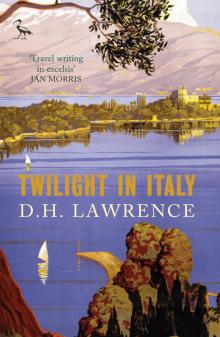 Twilight in Italy
Twilight in Italy The Trespasser
The Trespasser The Collected Short Stories
The Collected Short Stories The First Lady Chatterley's Lover
The First Lady Chatterley's Lover Kangaroo
Kangaroo Bay
Bay Complete Works of D.H. Lawrence
Complete Works of D.H. Lawrence D H Lawrence- The Dover Reader
D H Lawrence- The Dover Reader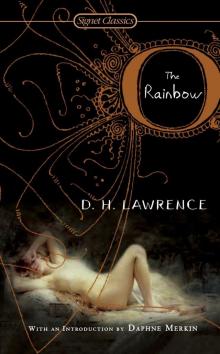 The Rainbow (100th Anniversary ed.)
The Rainbow (100th Anniversary ed.) The Prussian Officer
The Prussian Officer Women in Love (Barnes & Noble Classics Series)
Women in Love (Barnes & Noble Classics Series) John Thomas and Lady Jane
John Thomas and Lady Jane The Bad Side of Books
The Bad Side of Books Sons and Lovers (Barnes & Noble Classics Series)
Sons and Lovers (Barnes & Noble Classics Series) Selected Stories
Selected Stories Collected Short Stories
Collected Short Stories Complete Works of D.H. Lawrence (Illustrated)
Complete Works of D.H. Lawrence (Illustrated)